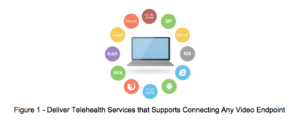- Allow checkups with patients at home through a web browser
- Enable specialists with iPads to videoconference to serve multiple clinics from home
- Host group therapy sessions for patients in remote locations through video conferencing
- Facilitate video communication among geographically dispersed clinics with video endpoint systems
- Help physicians on the road to connect with a telehealth endpoint system at their clinic
- Enable remote surgery and consultation in special cases
- Bridge rural clinics to the main location in a city, creating a foundation for knowledge sharing and telehealth
[bctt tweet=”Does your #telehealth network need a checkup? ” username=”vyopta”]
It is also important to ensure that the purchase of infrastructure, equipment, and video services stay within a budget so that telehealth services are not jeopardized in economic hardship or changing payment models (e.g., insurance reimbursement. self-pay).
Today there are many new options for enabling video communication for telehealth. Video communications infrastructure virtualization, hybrid video communications technologies and video services in the cloud have increased the options available and the complexity of the process of optimizing performance for quality, reliability and security of video communications.
Challenges With Current Telehealth Management Tools
Today, most video telehealth IT teams apply very simple methods (track call details, systems uptime, network quality) and use multiple tools (OEM real-time monitoring tools, 3rd party network and/or systems monitoring tools) that deliver minimal insight to help optimize their video communications environment. To create a truly robust and secure system, telehealth management teams need more information.
- Infrastructure capacity of call control managers, firewall traversal managers, domain federation managers, bridge/MCU servers, gateways, etc.
- Endpoint and infrastructure systems call quality (e.g., packet loss, jitter, latency).
- Endpoint and infrastructure systems reliability (e.g., uptime/availability).
This is fine when your video communications environment is small and call flows are simple.
Below are examples of simple to complex virtual meeting use cases that are supported by video telehealth services.
1.) In-network point-to-point virtual team calls
2.) In-network and out-of-network point-to-point virtual team calls (aka Traversal Calls)
3.) In-network virtual team conferences
4.) In-network and out-of-network virtual team conferences
In order to achieve the desired 99.999% (aka five nines) reliability of telehealth services using a variety video communication technologies and redundant systems for continuity, the data that managers receive from all these devices and systems increases exponentially in both volume and variety. For telehealth systems, this can quickly overwhelm even large IT teams and errors will start to propagate.
Solution
To support the required reliability and variety in telehealth, IT needs a robust “single pane of glass” analytics and real-time monitor solution that collects a wide array of data from all video communication technologies — infrastructure and endpoints.
The solution must also intelligently cleanse, transform and merge the data to drive 100% accuracy in delivering actionable insights and alerts. When this tool is accurate and inclusive of historic, current and future projected data, it can derive and deliver the information needed to optimally manage video infrastructure/endpoint systems performance. This includes the capacity to support the maximum number of required endpoints and calls (in-network and out-of-network) with minimal errors, minimum issues and reduced capital / operations costs. For example, a hospital using a remote surgical specialist during a surgery can make sure to monitor that specific endpoint in real time for call quality to maximize video, audio and content sharing clarity and dedicate capacity resources as well as backup resources, all from a single tool.

Alfredo Ramirez is a seasoned entrepreneur with direct experience in building early-stage software technology companies, which is why he proudly serves Vyopta as CEO and Co-Founder. A nod to his passion for pushing the button of innovation, Alfredo previously co-founded Vitalz (a venture backed enterprise software company acquired by Oracle) and Daman Consulting. He holds a B.S. in Electrical and Computer Engineering from The University of Texas at Austin and writes about topics such as technology, employee engagement, and innovation from the CEO perspective.







